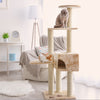How to Make the Purrfect Potty
- by Rufus and Coco
Litter box hygiene should not be taken lightly if you want your precious feline to avoid contracting urinary tract infection.
In this article, we give you some helpful advice on how to better manage litter box cleaning to prevent such mishaps from occurring.
5 Tips on How to Keep Your Litter Box Clean
Pick the right type of litter
Litters come in various shapes and sizes and can be made from multiple materials. These days, you can find some that are manufactured using recycled paper or cardboard, tofu, corn, and soy just to name a few.
Our own Wee Kitty Litter range is an excellent example of one that's made from natural, sustainable, and eco-friendly materials.

Not all cats are the same, so they might prefer one type of litter over the other depending on their preferences. Try several kinds until you find the one your kitty seems to favour.
One of the most important features when it comes to litter is its absorbency. If it doesn’t correctly absorb waste, especially your pet’s urine, you will not only have to deal with your cat’s waste, but also the smell that comes with it.
Using scented litters can be a hit or miss because some cats may not prefer the smell and completely ignore using the litter box altogether. The best way is for you to test one out first in small amounts and see how your feline responds to it.
Clean the litter box every day
This is a step that you can’t ignore. Not only will you be saving yourself from having to cope with all that nasty ammonia smell, but you will also prevent your cat from sitting in dirty litter whenever they ‘use the bathroom’. Use cleaning sprays to help you effectively clean and sanitise your kitty's box.
Depending on the type of litter you use, it might have pretty good clumping capabilities. If that’s the case, remove the clumps every single day along with your cat’s feces.
Change the litter once every several days or once a week, depending on the amount you to add to the box.
Get an excellent litter mat
Litter mats have started to become more and more popular in the past decade, and for a good reason, too. They make the task of gathering the used litter much easier.
Plus, they also make it impossible for the litter box to slip on the floor as you’re trying to gather the waste or as your cat is using it. Most litter mats are made from silicone and can be washed and reused time and again.
Clean the litter box every week
The litter box itself can be at the root of all the smell coming from your cat’s ‘toilet’.
What some pet parents might not be aware of is that the litter box needs to be replaced on a regular basis, once every six months or once a year.
Plastic litter boxes, as convenient as they might be when it comes to cleaning, tend to get scratched easily. This also means that in those scratches, there could be potentially pathogenic bacteria just waiting for the right moment to attack.
As much as you might try to clean them thoroughly, these litter boxes will retain some of these microorganisms, which means that at one point, they will have to be replaced.
When it comes to actual litter box hygiene, the best way of going about things is to have two separate ones. If you want to use chemical products for cleaning and disinfecting the box, your cat is not going to appreciate the smell of these solutions, so they might not want to use the litter box at all right after you’ve cleaned it.
This is why you should have a backup and switch between two litter boxes depending on when you clean them.
Use a box liner
This is a relatively new type of product that didn’t exist until several years ago, but the truth is that it can make your life as a cat guardian much easier.
If your litter box makes it possible for you to use a liner, you will be able to gather the litter and replace it more conveniently. In the end, no one wants to spend a lot of time in close proximity to used litter, so this could be one solution to your problem.
Final Thoughts
To make the experience as comfortable as possible for your cat, you should never keep your litter box right next to their food and water dishes.
In the wild, cats do not eliminate in places they enjoy the prey they have caught, so do consider that. They are generally clean animals, so they do not eat and ‘use the toilet’ in the same spot.
If you have several cats, you should always keep at least one litter box for each of them. Using the same litter for different cats can lead to disaster since cats can easily pass UTI from one to the other in this way.
References
Litter box preference in domestic cats: covered versus uncovered, Emma K. Grigg et al, 2013: https://pubmed.ncbi.nlm.nih.gov/23103684/
Does previous use affect litter box appeal in multi-cat households? J.J. Ellis et al, 2017: https://pubmed.ncbi.nlm.nih.gov/28216119/
The behavioral effects of innovative litter developed to attract cats, Jennifer Frayne et al, 2019: https://www.ncbi.nlm.nih.gov/pmc/articles/PMC6770919/










